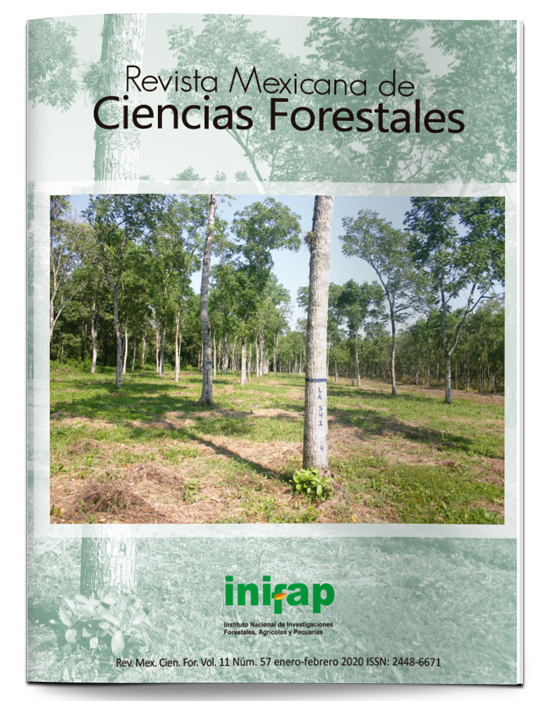Evaluación del refuerzo de asierre en madera seca y cepillada del ejido Pueblo Nuevo, Durango
DOI:
https://doi.org/10.29298/rmcf.v11i57.645Palabras clave:
Calidad de aserrío, control estadístico de procesos, eficiencia, madera aserrada, rendimiento, variación de corteResumen
La calidad dimensional de la madera aserrada es variable en función de los métodos de trabajo, el grado de mantenimiento y precisión de los equipos de asierre; además sus implicaciones en la madera seca y cepillada no se han documentado. El objetivo de este trabajo fue determinar, si el grueso de asierre de 7/8” (22.23 mm) garantiza obtener madera seca y cepillada con dimensión final coincidente a la nominal. A una muestra de 150 tablas de Pinus sp producidas en el aserradero La Peña, se le dio seguimiento durante los procesos de secado y cepillado para conocer la variación dimensional, mediante un control estadístico de procesos; con esos datos se cuantificó el volumen que no alcanzó la dimensión nominal final y se determinó que la desviación estándar total del proceso de aserrío (St) fue de 0.85 mm, en la cual influyó que los cortes de la sierra no son homogéneos dentro de las tablas, lo que dificulta obtener piezas con calidad de superficie y precisión dimensional adecuadas para el cepillado. El control de calidad evidenció que 67.50 % de las tablas cepilladas estuvieron dentro de los límites de control de calidad dimensional (20.92 a 22.32 mm); 15.83 % por encima del límite de control superior, y ambas representaron 83.33 % del volumen total con buena dimensión nominal final; mientras que 16.67 % no la tuvieron, ya que presentaron subdimensiones en grosor. Se concluye que la variación del corte en este aserradero compromete hasta 17 % de la materia prima.
Descargas
Descargas
Publicado
Cómo citar
Número
Sección
Licencia
Los autores que publiquen en la Revista Mexicana de Ciencias Forestales aceptan las siguientes condiciones:
De acuerdo con la legislación de derechos de autor, la Revista Mexicana de Ciencias Forestales reconoce y respeta el derecho moral de los autores, así como la titularidad del derecho patrimonial, el cual será cedido a la revista para su difusión en acceso abierto.
Todos los textos publicados por la Revista Mexicana de Ciencias Forestales –sin excepción– se distribuyen amparados bajo la licenciaCreative Commons 4.0 Atribución-No Comercial (CC BY-NC 4.0 Internacional), que permite a terceros utilizar lo publicado siempre que mencionen la autoría del trabajo y a la primera publicación en esta revista. (no permite el uso comercial)
Los autores pueden realizar otros acuerdos contractuales independientes y adicionales para la distribución no exclusiva de la versión del artículo publicado en la Revista Mexicana de Ciencias Forestales (por ejemplo, incluirlo en un repositorio institucional o darlo a conocer en otros medios en papel o electrónicos) siempre que indique clara y explícitamente que el trabajo se publicó por primera vez en la Revista Mexicana de Ciencias Forestales.
Para todo lo anterior, los autores deben remitir el formato de carta-cesión de la propiedad de los derechos de la primera publicación debidamente requisitado y firmado por los autores/as. Este formato debe ser remitido en archivo PDF al correo: editorial.forestal@inifap.gob.mx
Esta obra está bajo una licencia de Creative Commons Reconocimiento-No Comercial 4.0 Internacional.






